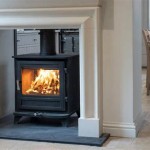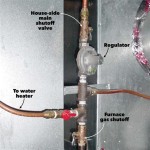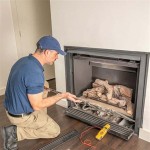Remote Fireplace Control: Enhanced Comfort and Convenience
The integration of technology into home heating systems has significantly advanced the convenience and control offered to homeowners. Remote fireplace control represents a prime example of this advancement, enabling users to manage their fireplaces from virtually anywhere with an internet connection. This capability extends beyond simple on/off functionality, encompassing features such as temperature adjustment, flame height regulation, and scheduled operation.
The fundamental principle underpinning remote fireplace control involves a communication pathway between the fireplace and a user interface, typically a smartphone application or web-based platform. This pathway typically relies on wireless communication protocols such as Wi-Fi or Bluetooth, allowing the fireplace to receive commands and transmit status updates. The central component facilitating this communication is a control module integrated into the fireplace itself, which interprets the received signals and executes the corresponding actions. This module is often designed to be compatible with existing fireplace models, allowing for retrofit installations in addition to being incorporated into new fireplace designs.
The benefits of remote fireplace control are multifaceted. It offers unparalleled convenience, allowing users to preheat their homes before arrival, adjust the ambiance without leaving their seats, and even monitor the fireplace's operation remotely for safety and security. Furthermore, it can contribute to energy efficiency by enabling precise temperature regulation and scheduled operation, preventing unnecessary energy consumption. Finally, the integration of smart home technology allows for seamless integration with other devices and systems, creating a unified and automated home environment.
Enhanced Convenience and Accessibility
Remote fireplace control fundamentally transforms the user experience by providing unprecedented convenience and accessibility. Traditionally, operating a fireplace involved manual manipulation of controls located directly on the unit. This could be inconvenient, especially in large rooms or for individuals with mobility limitations. Remote control eliminates this physical barrier, allowing users to manage their fireplace from anywhere within range of the designated communication network.
The primary interface for remote control is typically a smartphone application or a web-based platform. These interfaces are designed to be intuitive and user-friendly, providing a clear and concise overview of the fireplace's status and offering a range of control options. Users can typically turn the fireplace on or off, adjust the flame height or heat output, set timers for automatic operation, and monitor the current temperature of the room. Some systems also offer advanced features such as customized profiles for different users or scenarios.
The accessibility benefits of remote fireplace control extend beyond simple convenience. For individuals with limited mobility, such as the elderly or those with disabilities, the ability to control a fireplace remotely can significantly enhance their quality of life. It eliminates the need to physically approach the fireplace, reducing the risk of falls or other accidents. Furthermore, the remote monitoring capabilities allow caregivers to ensure the safety and comfort of individuals who may be unable to manage the fireplace themselves.
Consider a scenario where a homeowner is returning from a long day at work. Using the remote control application on their smartphone, they can activate the fireplace a few minutes before arriving home, creating a warm and inviting atmosphere upon entry. Alternatively, imagine a situation where a homeowner is traveling and wants to ensure that their home is not excessively cold during winter. They can remotely monitor the temperature and adjust the fireplace settings as needed, preventing potential damage from freezing pipes.
The convenience and accessibility offered by remote fireplace control are not merely superficial advantages. They represent a fundamental improvement in the user experience, making it easier and more enjoyable to operate a fireplace. This can lead to increased usage and appreciation of the fireplace as a valuable heating and aesthetic feature in the home.
Energy Efficiency and Cost Savings
Beyond convenience, remote fireplace control contributes to increased energy efficiency and potential cost savings. Traditional fireplaces, particularly older models, can be inefficient in their energy consumption, leading to higher heating bills and a greater environmental impact. Remote control systems often incorporate features that optimize energy usage and minimize waste.
One key aspect of energy efficiency is precise temperature regulation. Remote control allows users to set specific temperature targets and maintain them consistently. This eliminates the fluctuations in temperature that can occur with manual control, preventing the fireplace from overheating the room or using more energy than necessary. Some systems also incorporate sensors that monitor the room temperature and automatically adjust the fireplace output to maintain the desired level.
Scheduled operation is another important feature that contributes to energy savings. Users can set timers for the fireplace to turn on and off at specific times, ensuring that it is only operating when needed. This can be particularly useful for heating a room in the morning or evening, without having to manually turn the fireplace on and off. Some systems also allow for more complex scheduling, such as different settings for weekdays and weekends.
Zoning capabilities are also relevant to energy efficiency. Some advanced remote control systems allow users to divide their homes into different zones and control the heating in each zone independently. This enables them to focus heating on the areas that are being used, rather than heating the entire house unnecessarily. For example, they can heat the living room in the evening while keeping the bedrooms cooler.
Consider a situation where a homeowner typically leaves their fireplace running throughout the day, even when they are not at home. With remote control and scheduled operation, they can program the fireplace to turn off automatically when they leave for work and turn back on shortly before they return home. This simple change can result in significant energy savings over time. Furthermore, the precise temperature regulation features can prevent the fireplace from overheating the room, reducing energy waste and improving comfort.
The potential cost savings associated with energy-efficient remote fireplace control can be substantial, particularly for homes that rely heavily on fireplaces for heating. By reducing energy consumption and optimizing heating schedules, users can significantly lower their heating bills and reduce their overall energy footprint. This makes remote fireplace control not only a convenient feature but also a financially and environmentally responsible choice.
Smart Home Integration and Enhanced Safety
The integration of remote fireplace control with smart home ecosystems further enhances its functionality and benefits, adding a layer of convenience, automation, and safety. Modern smart home platforms allow for seamless communication and control between various devices, enabling users to create interconnected and automated home environments.
A central element of smart home integration is voice control. Many remote fireplace control systems are compatible with popular voice assistants such as Amazon Alexa and Google Assistant. This allows users to control their fireplace using simple voice commands, such as "Alexa, turn on the fireplace" or "Hey Google, set the fireplace to 70 degrees." This hands-free control is particularly convenient when users are occupied with other tasks or have limited mobility.
Integration with other smart home devices can also enhance the functionality of remote fireplace control. For example, a smart thermostat can communicate with the fireplace to maintain a consistent temperature throughout the house. A smart lighting system can be programmed to adjust the lighting levels when the fireplace is turned on, creating a more cozy and inviting atmosphere. A smart security system can monitor the fireplace and alert the homeowner if there are any issues, such as a malfunction or a gas leak.
Safety is a paramount consideration in fireplace operation, and remote control systems can incorporate features that enhance safety and reduce the risk of accidents. Some systems include sensors that monitor the carbon monoxide levels in the room and automatically shut off the fireplace if dangerous levels are detected. Others have built-in timers that automatically turn off the fireplace after a certain period of time, preventing it from being left unattended for too long.
Remote monitoring capabilities also contribute to safety. Homeowners can remotely check the status of their fireplace to ensure that it is operating properly and that there are no potential problems. This can be particularly useful when they are away from home for extended periods of time. Some systems also send alerts to the homeowner if there are any issues, such as a power outage or a malfunction.
Imagine a scenario where a homeowner is away on vacation and receives an alert on their smartphone indicating that the carbon monoxide levels in their home are elevated. Thanks to the remote monitoring capabilities of their smart fireplace system, they can immediately contact the authorities and prevent a potentially dangerous situation. Alternatively, consider a situation where a homeowner forgets to turn off the fireplace before leaving for work. Using their smartphone, they can remotely shut off the fireplace, preventing a potential fire hazard.
The integration of remote fireplace control with smart home technology represents a significant advancement in home automation and safety. By enabling seamless communication and control between various devices, these systems create a more convenient, comfortable, and secure living environment. The combination of voice control, smart device integration, and enhanced safety features makes remote fireplace control a valuable addition to any modern home.

Gas Fireplace Remotes More Fireplaceremotecontrols Com

Skytech 1001th Thermostat Fireplace Remote Control

20 14 028 Fireplace Remote Control

Kingsman Fireplaces Gtmrcp Remote Control Millivolt

Sit Gas Fireplace Or Stove Remote Control Wall Bracket Hechler S Mainstreet Hearth Home Troy Missouri

Skytech 3301 Timer Thermostat Fireplace Remote Control

Superior Trc Lcd Fireplace Remote With Thermostatic On Off Controls Receiver

Everwarm Thermostat Remote Control Us Fireplace

Rck K Series Gas Fireplace Remote Control Kit From Hpc

Superior Rc S 1 Dual On Fireplace Remote With Timer Off Controls
Related Posts








